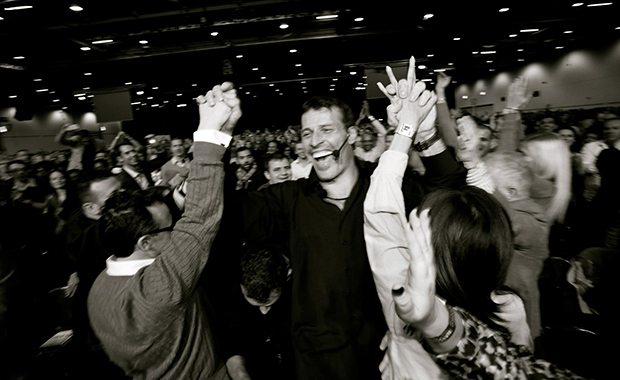Life
How to Make Your Work More Impactful

A few years ago, I had my first piece of writing go “viral.” It was called “An Open Letter To Frustrated 20-Somethings” and it started off as a Facebook rant that got picked up and spread all over the world.
Fascinated by the experience, I wanted to make it happen again. I wanted to know the science behind writing something that spread. The first time, I’d done it by accident. Now I wanted to intentionally create the viral effect. So I started asking people who were much smarter than me and had a history of creating work that spread.
The first person I asked was Seth Godin. If you don’t know who Seth is, go to Amazon right now and buy any one of his books. I hit Seth up and asked him about the whole “going viral thing” and how I could make it happen again.
His response to me was pretty surprising:
“The best thing is not to try to write things that will go viral. The best thing is to write for just one person. Make an impact on just one person. Even better, make it so they can’t sleep at night unless the choose to make a difference for one other person. The rest will take care of itself.”
At the time, I understood what he meant intellectually. But I didn’t really know how to put it into practice. Even a few years into the game, after I’ve had several pieces of writing make a big splash, I’d never really taken a second to dig deeper into what he said. But today at the gym, it all clicked synchronistically as I was scrolling through Spotify for something to listen to.
“Success is not measured in the amount of dollars you make, but the amount of lives you impact.”
I opened up my playlist and thumbed to the songs that get me pumped up. I landed on “Lean On” by Major Lazer. Have you heard this song before? It’s incredible. It’s just really good music with a captivating video. And I’m not the only one who thinks so. It has almost a BILLION views on YouTube.
Let that sink in. If those views were all coming from unique visitors, that’d mean almost 15% of the entire world had heard this song. And those are just YouTube views. NUTS. But something else even cooler is going on. The song has 10+ different versions on Spotify — all remixes and re-imaginings by different artists. There’s even a slow acoustic country version! Such a collection of variations for one track is super rare on Spotify, which usually only has one (maybe two) versions of each song.
THIS is what Seth meant.
For some reason, this is a song that got people to CARE. Care enough that it got viewed/shared a BILLION times. Care enough that other artists spent their time creating and sharing their own versions of this song. Because it was that damn good.
To my knowledge, there weren’t any complex marketing campaigns designed to push the song into the stratosphere. It was just so good that people couldn’t help but watch it, share it and remake it. They couldn’t sleep at night without passing it on.
“Everyday you create your history. Every path you take you leave your legacy.”
And come to think of it, I feel the same about Seth’s newest book, “What To Do When It’s Your Turn.” I read the book in 2 days, and immediately after, bought 10 other copies to give to my team, my family and friends.
Buying books in bulk to pass out isn’t something that I normally do. But in this instance, the book was so damn good that my immediate thought was, “If everybody was able to read what I just read, the world would be a much better place.” So I literally had NO choice but to pass it out. I literally left a copy at my neighbor’s doorstep with an inscription: “Do great work. Have an amazing day.” I didn’t even want credit for giving the gift. Totally anonymous.
After reading it, I felt OBLIGATED to show it to people — if only because I knew that after reading it, the people I’d passed it out to would probably be just as inspired as I was. That alone was reward enough. THIS type of selfless sharing effect is what Seth Godin was talking about.
So what’s the secret to making something go viral? It starts with making something that people have no choice but to care about. Something both so personal, but so simultaneously universal and human that not sharing it would seem selfish or “out of whack.”
Now, what you go about creating is totally up to you. It may take 100 or 1,000 tries to make something that has such an impact on people. But if your goal is to make other people genuinely CARE about what you have to say — not in the general social media “like” way — but actually feel it…you’ll have no problem going viral.
Have you had content go viral before? What tips would you add to this list to help create content that has a huge impact?
Did You Know
How Skilled Migrants Are Building Successful Careers After Moving Countries
Behind every successful skilled migrant career is a mix of resilience, strategy, and navigating systems built for locals.

Moving to a new country for work is exciting, but it can also be unnerving. Skilled migrants leave behind familiar systems, networks, and support to pursue better job opportunities and a better future for their families. (more…)
Life
10 Research-Backed Steps to Create Real Change This New Year
This New Year could finally be the one where you break old patterns and create real, lasting change.

Every New Year, we make plans and set goals, but often repeat old patterns. (more…)
Life
9 Harsh Truths Every Young Man Must Face to Succeed in the Modern World
Before chasing success, every young man needs to face these 9 brutal realities shaping masculinity in the modern world.

Many young men today quietly battle depression, loneliness, and a sense of confusion about who they’re meant to be.
Some blame the lack of deep friendships or romantic relationships. Others feel lost in a digital world that often labels traditional masculinity as “toxic.”
But the truth is this: becoming a man in the modern age takes more than just surviving. It takes resilience, direction, and a willingness to grow even when no one’s watching.
Success doesn’t arrive by accident or luck. It’s built on discipline, sacrifice, and consistency.
Here are 9 harsh truths every young man should know if he wants to thrive, not just survive, in the digital age.
1. Never Use Your Illness as an Excuse
As Dr. Jordan B. Peterson often says, successful people don’t complain; they act.
Your illness, hardship, or struggle shouldn’t define your limits; it should define your motivation. Rest when you must, but always get back up and keep building your dreams. Motivation doesn’t appear magically. It comes after you take action.
Here are five key lessons I’ve learned from Dr. Peterson:
-
Learn to write clearly; clarity of thought makes you dangerous.
-
Read quality literature in your free time.
-
Nurture a strong relationship with your family.
-
Share your ideas publicly; your voice matters.
-
Become a “monster”, powerful, but disciplined enough to control it.
The best leaders and thinkers are grounded. They welcome criticism, adapt quickly, and keep moving forward no matter what.
2. You Can’t Please Everyone And That’s Okay
You don’t need a crowd of people to feel fulfilled. You need a few friends who genuinely accept you for who you are.
If your circle doesn’t bring out your best, it’s okay to walk away. Solitude can be a powerful teacher. It gives you space to understand what you truly want from life. Remember, successful men aren’t people-pleasers; they’re purpose-driven.
3. You Can Control the Process, Not the Outcome
Especially in creative work, writing, business, or content creation, you control effort, not results.
You might publish two articles a day, but you can’t dictate which one will go viral. Focus on mastery, not metrics. Many great writers toiled for years in obscurity before anyone noticed them. Rejection, criticism, and indifference are all part of the path.
The best creators focus on storytelling, not applause.
4. Rejection Is Never Personal
Rejection doesn’t mean you’re unworthy. It simply means your offer, idea, or timing didn’t align.
Every successful person has faced rejection repeatedly. What separates them is persistence and perspective. They see rejection as feedback, not failure. The faster you learn that truth, the faster you’ll grow.
5. Women Value Comfort and Security
Understanding women requires maturity and empathy.
Through books, lectures, and personal growth, I’ve learned that most women desire a man who is grounded, intelligent, confident, emotionally stable, and consistent. Some want humor, others intellect, but nearly all want to feel safe and supported.
Instead of chasing attention, work on self-improvement. Build competence and confidence, and the rest will follow naturally.
6. There’s No Such Thing as Failure, Only Lessons
A powerful lesson from Neuro-Linguistic Programming: failure only exists when you stop trying.
Every mistake brings data. Every setback builds wisdom. The most successful men aren’t fearless. They’ve simply learned to act despite fear.
Be proud of your scars. They’re proof you were brave enough to try.
7. Public Speaking Is an Art Form
Public speaking is one of the most valuable and underrated skills a man can master.
It’s not about perfection; it’s about connection. The best speakers tell stories, inspire confidence, and make people feel seen. They research deeply, speak honestly, and practice relentlessly.
If you can speak well, you can lead, sell, teach, and inspire. Start small, practice at work, in class, or even in front of a mirror, and watch your confidence skyrocket.
8. Teaching Is Leadership in Disguise
Great teachers are not just knowledgeable. They’re brave, compassionate, and disciplined.
Teaching forces you to articulate what you know, and in doing so, you master it at a deeper level. Whether you’re mentoring a peer, leading a team, or sharing insights online, teaching refines your purpose.
Lifelong learners become lifelong leaders.
9. Study Human Nature to Achieve Your Dreams
One of the toughest lessons to accept: most people are self-interested.
That’s not cynicism, it’s human nature. Understanding this helps you navigate relationships, business, and communication more effectively.
Everyone has a darker side, but successful people learn to channel theirs productively into discipline, creativity, and drive.
Psychology isn’t just theory; it’s a toolkit. Learn how people think, act, and decide, and you’ll know how to lead them, influence them, and even understand yourself better.
Final Thoughts
The digital age offers endless opportunities, but only to those who are willing to take responsibility, confront discomfort, and keep improving.
Becoming a man today means embracing the hard truths most avoid.
Because at the end of the day, success isn’t about luck. It’s about who you become when life tests you the most.
Change Your Mindset
The Four Types of Happiness: Which One Are You Living In?
Most people chase success only to find emptiness, this model reveals why true happiness lies somewhere else.

In a world driven by rapid technological growth and constant competition, many people unknowingly trade joy for achievement. (more…)
-

 Entrepreneurs4 weeks ago
Entrepreneurs4 weeks agoThe Essential Skills Every Entrepreneur Needs In 2026
-

 Change Your Mindset3 weeks ago
Change Your Mindset3 weeks agoHow to Turn Your Mind Into Your Greatest Asset (Instead of Your Enemy)
-

 Change Your Mindset3 weeks ago
Change Your Mindset3 weeks agoThe Silent Skill That Makes People Respect You Instantly
-

 Life3 weeks ago
Life3 weeks ago10 Research-Backed Steps to Create Real Change This New Year
-

 Tech2 weeks ago
Tech2 weeks agoWhat’s in a Name? How to Get Your Domain Right
-

 Did You Know2 weeks ago
Did You Know2 weeks agoHow Skilled Migrants Are Building Successful Careers After Moving Countries

























3 Comments